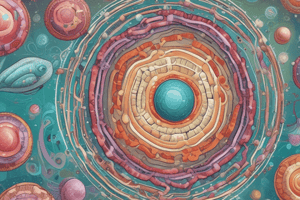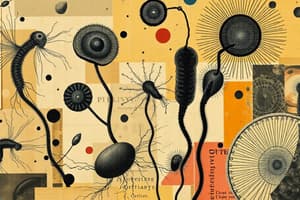Podcast
Questions and Answers
Protists are classified into the Domain Bacteria.
Protists are classified into the Domain Bacteria.
False (B)
Protists are a kingdom comprising only eukaryotic organisms that are not animals, plants, or fungi.
Protists are a kingdom comprising only eukaryotic organisms that are not animals, plants, or fungi.
True (A)
All protists are multicellular, forming complex colonies with specialized cells.
All protists are multicellular, forming complex colonies with specialized cells.
False (B)
Protists move by extending their cytoplasm into extensions called flagella.
Protists move by extending their cytoplasm into extensions called flagella.
Amoebas use pseudopodia, temporary cytoplasmic extensions, for movement and capturing prey.
Amoebas use pseudopodia, temporary cytoplasmic extensions, for movement and capturing prey.
Binary fission in protists involves the exchange of genetic material between two cells, resulting in increased genetic diversity.
Binary fission in protists involves the exchange of genetic material between two cells, resulting in increased genetic diversity.
Conjugation in paramecia results in offspring with a combination of genetic material from both parent cells.
Conjugation in paramecia results in offspring with a combination of genetic material from both parent cells.
Plasmodium, the protist that causes malaria, reproduces only asexually within both mosquito and human hosts.
Plasmodium, the protist that causes malaria, reproduces only asexually within both mosquito and human hosts.
The life cycle of Plasmodium involves both sexual and asexual reproduction, utilizing both mosquitoes and humans as hosts.
The life cycle of Plasmodium involves both sexual and asexual reproduction, utilizing both mosquitoes and humans as hosts.
Protists are mainly classified based on their genetic similarities determined through DNA sequencing.
Protists are mainly classified based on their genetic similarities determined through DNA sequencing.
Animal-like protists, also known as protozoa, are autotrophic organisms capable of producing their own food through photosynthesis.
Animal-like protists, also known as protozoa, are autotrophic organisms capable of producing their own food through photosynthesis.
Plant-like protists, known as fungi, are heterotrophic and perform decomposition.
Plant-like protists, known as fungi, are heterotrophic and perform decomposition.
Fungi-like protists are heterotrophic organisms that obtain nutrients by decomposing organic matter.
Fungi-like protists are heterotrophic organisms that obtain nutrients by decomposing organic matter.
Protists are exclusively microscopic organisms, invisible to the naked eye.
Protists are exclusively microscopic organisms, invisible to the naked eye.
All protists are harmful and cause diseases in humans and other organisms.
All protists are harmful and cause diseases in humans and other organisms.
Protists never have chloroplasts.
Protists never have chloroplasts.
Slime molds are classified as animal-like protists due to their ability to move and engulf food particles.
Slime molds are classified as animal-like protists due to their ability to move and engulf food particles.
Protists do not exhibit sexual reproduction.
Protists do not exhibit sexual reproduction.
Protists are considered a monophyletic group, meaning they all share a single common ancestor.
Protists are considered a monophyletic group, meaning they all share a single common ancestor.
Protists are important primary producers in aquatic ecosystems, converting sunlight into energy through photosynthesis.
Protists are important primary producers in aquatic ecosystems, converting sunlight into energy through photosynthesis.
Flashcards
What are Protists?
What are Protists?
Eukaryotic organisms that are not animals, plants, or fungi.
Domain of Protists
Domain of Protists
Eukarya.
Kingdom of Protists
Kingdom of Protists
Protista.
Protist Definition
Protist Definition
Signup and view all the flashcards
Protist Cell Structure
Protist Cell Structure
Signup and view all the flashcards
Protist Organization
Protist Organization
Signup and view all the flashcards
Protist Motility
Protist Motility
Signup and view all the flashcards
What are Pseudopodia?
What are Pseudopodia?
Signup and view all the flashcards
Binary Fission
Binary Fission
Signup and view all the flashcards
Conjugation in Protists
Conjugation in Protists
Signup and view all the flashcards
Protist Reproduction
Protist Reproduction
Signup and view all the flashcards
Plasmodium Reproduction
Plasmodium Reproduction
Signup and view all the flashcards
Protist Classification
Protist Classification
Signup and view all the flashcards
Animal-like Protists
Animal-like Protists
Signup and view all the flashcards
Fungi-like Protists
Fungi-like Protists
Signup and view all the flashcards
Plant-like Protists
Plant-like Protists
Signup and view all the flashcards
Plant-like Protists
Plant-like Protists
Signup and view all the flashcards
Study Notes
- Protists are a broad group of eukaryotic organisms that are not animals, plants, or fungi.
Classification of Protists
- Protists are in the Eukarya domain and Protista kingdom.
- Protists are considered 'uncategorizable' because they don't fit neatly into the animal, plant, or fungus kingdoms.
General characteristics of protists
- Protists have a typical eukaryotic cell structure.
- Protists are mostly unicellular or form colonies
Movement in Protists
- Protists move towards food or to escape predators
- Some protists stream cytoplasm into extensions called pseudopodia for movement.
- Amoebas use pseudopodia to creep slowly in a direction.
Reproduction in Protists
- Protists like amoebas, paramecia, and most ciliates reproduce through binary fission.
- Paramecia can exchange genetic material through conjugation, but this does not produce offspring.
- Many protists alternate between sexual and asexual reproduction.
- Slime molds and Plasmodium (the cause of malaria) reproduce in this way
Classifying Types of Protists
- Protists are classified based on their lifestyle.
- The three groups are: animal-like, plant-like, and fungi-like protists.
Animal-like Protists
- Animal-like protists are also known as protozoa.
- Protozoa are heterotrophic, meaning they capture and ingest food.
Plant-like Protists
- Plant-like protists are also known as algae.
- Algae are photosynthetic, creating food using light
- Photosynthetic protists contain chloroplasts
Fungi-like Protists
- Fungi-like protists are heterotrophic, feeding on decaying organic matter.
- Fungi-like protists are also referred to as decomposers.
Studying That Suits You
Use AI to generate personalized quizzes and flashcards to suit your learning preferences.




